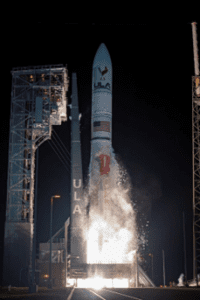TAG: GS 3: SCIENCE AND TECHNOLOGY
THE CONTEXT: The Peregrine lander, developed by a private US company, and launched via the Vulcan rocket, represents a significant milestone in space exploration.
EXPLANATION:
- It is part of NASA’s Commercial Lunar Payload Services (CLPS) initiative, aligning with the Artemis program aiming for a return to the Moon.

Objective and Payloads:
- The mission aims to achieve the first landing of a private spacecraft on the Moon, with the Peregrine lander carrying five payloads from NASA.
- These instruments are intended for diverse exploratory tasks, including detecting water and deploying a Laser Retroreflector Array for precise measurements.
- The involvement of private space companies, Astrobotic Technology and United Launch Alliance, signifies NASA’s collaboration with the private sector in its ambitious lunar exploration programs.
- It emphasized the involvement of private entities in space missions.
Technical Issues and Challenges:
- Post-launch, the spacecraft encountered technical problems that could potentially impact its mission.
- The obstacle related to achieving a stable orientation could affect solar power battery charging, potentially jeopardizing the entire mission.
- Efforts are underway to rectify the issue.
Historical Context – US Moon Landing:
- The last US spacecraft to land on the Moon was Apollo 17 in 1972.
- This mission, part of the Apollo series, marked the last human presence on the lunar surface.
- Since then, NASA’s lunar exploration focused on orbiters studying the Moon’s surface from a distance.
Artemis Program and Future Missions:
- The Artemis program signifies the US’s renewed interest in the Moon, aiming for extended stays and eventual human landings.
- The series of planned missions, including crewed ones, intend to establish a permanent base for comprehensive exploration and scientific study of the Moon.
Collaboration with Private Sector:
- NASA’s CLPS initiative involves collaboration with private companies to transport payloads to the Moon.
- With contracts awarded to multiple firms, this partnership aims to foster a commercial space market, stimulating innovation in lunar exploration technology and science.
Implications and Statements:
- NASA officials highlighted the significance of this mission for both science and the commercial space industry.
- The successful completion of high-risk missions like these contributes to new scientific insights and supports the growing space economy, showcasing American technological strength and innovation.
Conclusion:
- The launch of the Peregrine lander represents a pivotal step in space exploration, merging public-private partnerships in lunar missions.
- Despite initial technical setbacks, this mission, if successful, will contribute significantly to scientific understanding and lay the groundwork for future endeavors in human space exploration.
- This comprehensive analysis highlights the mission’s significance, challenges faced, historical context, future implications, and the collaborative nature of space exploration between NASA and the private sector.
- It underscores the broader impact of the US’s return to lunar exploration.

